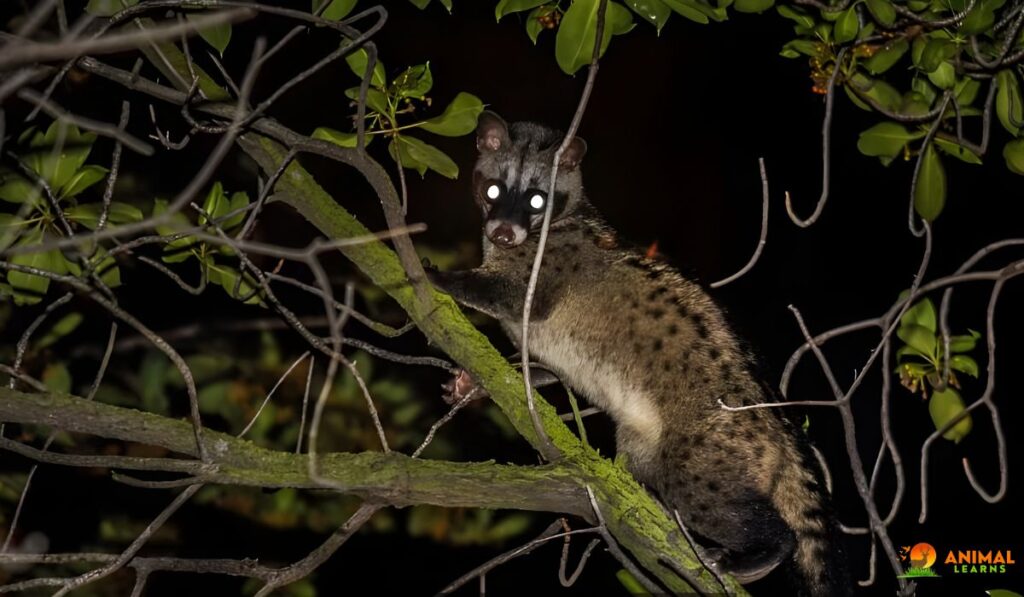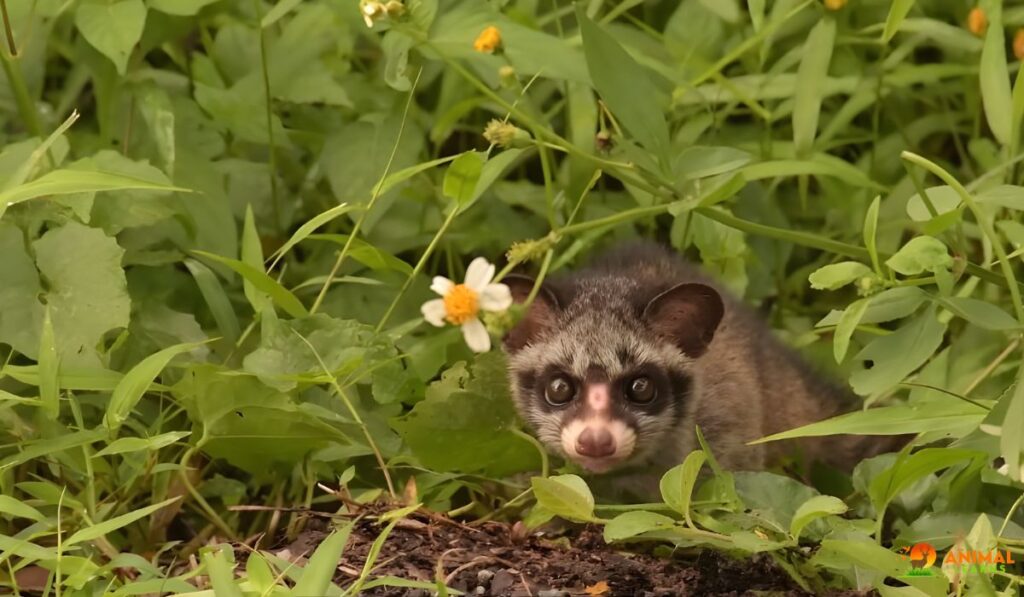African Palm Civet: Diet, Habitat, Facts (With Pictures)

The African Palm civet, also known as the two-spotted Palm civet, is a small, nocturnal mammal that belongs to the family Viverridae. They are fascinating animals that live in the forests of Africa. They have a wide range, from Senegal to Kenya, and from Angola to Mozambique. They can even be found on an island off Tanzania.
African palm civets are mostly arboreal, nocturnal creatures that live in the tree canopy, mostly perched on big branches and surrounded by lianas. Males have home ranges of 34-153 ha (0.13-0.59 sq mi), whereas females have ranges of 29-70 ha (0.11-0.27 sq mi). They are solitary. A dominant male’s home range usually encompasses the home ranges of multiple females.
The Appearance
Contents

Despite looking and acting like cats, these Civets are not related to cats; rather, they are closely linked to other small carnivores like as genets, mongooses, and weasels. Their thick fur, which ranges in hue from brown to light tan to yellow and is speckled with a variety of darker brown patches, is one of their most distinctive characteristics.
The civet may blend in with the trees more easily since the top half of its body has darker fur. The African Palm Civet has characteristics with other civet species, such as a pointed nose and relatively short yet powerful limbs. Their eyes are yellow-green with slit-shaped pupils, and they have short, rounded ears.
Physical Characteristics of African Palm Civets
These are small mammals that belong to the Viverridae family, which includes mongooses, genets, and binturongs. They have a distinctive appearance and behavior that make them unique among their relatives. Some of their physical characteristics are:
- Size and Weight: These animals measure between 40 and 55 centimeters (16 and 22 inches) from head to tail, and have a bushy tail of similar length. They weigh around 1 to 2 kilograms (2.2 to 4.4 pounds), which is comparable to a domestic cat.
- Fur Color and Pattern: Their fur ranges from reddish-brown to gray, with darker spots and stripes that help them camouflage in the forest. Their fur also has a musky odor, which comes from the scent glands near their anus.
- Eye Shape and Function: Their eyes are large and round, which gives them excellent night vision. They use their eyes to spot prey and predators in the dark, as well as to communicate with other civets.
- Tail Shape and Function: Their tail is semi-prehensile, meaning it can wrap around branches and objects. They use their tail to balance themselves while climbing and jumping in the trees.
- Claw Shape and Function: Their claws are sharp and curved, which allows them to grip on tree bark and dig in the soil. They use their claws to hunt, defend themselves, and mark their territory.
Diet

An important component of the Palm Civet’s ecological function is its nutrition. The equilibrium of their habitats is significantly maintained by these omnivorous animals. They are essential seed dispersers since they eat insects, small animals, birds, fruits, and palm oil.
They help plant species, especially those that depend on animal dispersion processes, to regenerate by eating a range of nutrients.
This dietary variety emphasizes how crucial they are to the complex network of African rainforest ecosystems, emphasizing the necessity for conservation efforts to safeguard both these mysterious animals and the plant life they support.
Habitat and Distribution
In most of eastern Africa, the African palm civet can be found living in tropical forests and jungles. It can also be found in some areas of central and western Africa, where its natural habitats are still present. These days, it can be found throughout Angola, from southern Sudan to Guinea, and even eastern Zimbabwe.
Due to their remarkable adaptability, African palm civets can be found in a broad range of environments, including savanna woodlands, rivers, lowland rainforests, and deciduous forests. However, deforestation is threatening the African palm civet in a large portion of its natural habitat, resulting in the degradation or complete loss of many of its historical locations.
Behavior and Lifestyle

The African Palm Civet is a solitary, crepuscular mammal that only comes out for a few hours at dawn and dusk to hunt food. They are mostly arboreal animals, spending a large portion of the day and night comfortably resting in the shade of the trees. Although these are generally solitary creatures, they have been observed to form groups of up to 15 when food is plentiful.
Strong-smelling compounds are secreted by two sets of scent glands in African palm civets. These glandular secretions, which are located on the lower region of their abdomen and between the third and fourth toes on each foot, are mainly used for mating and territory marking.
Interesting Facts and Anecdotes

Do you love coffee? If so, you might have heard of civet coffee, or “kopi luwak” as it is also called. This is a rare and expensive type of coffee that is made from beans that have been eaten and digested by African Palm Civets.
These small mammals have a taste for coffee cherries, and some people believe that their digestive enzymes improve the flavor of the beans. But did you know that there is more to these animals than their role in producing civet coffee? Here are some fascinating facts about African Palm Civets that you might not know:
- They are not really civets: Despite their name, They are not closely related to other civets or small carnivores. They belong to their own unique family, Nandiniidae, which makes them very special in the animal kingdom.
- They are seed dispersers: They are not picky eaters. They enjoy a variety of fruits, and they help spread the seeds of these plants in different areas of their habitat. This way, they contribute to the diversity and health of their ecosystems.
- They are night owls: They are mostly active at night when they hunt for food and avoid predators. They are also very solitary and shy, which makes them hard to observe in the wild.
They scientifically known as Nandinia binotata, are a captivating creature native to sub-Saharan Africa. Its enigmatic nature and unique behaviors make it a subject of interest among wildlife enthusiasts. Delving into African Palm Civet Facts unveils its dietary habits, which include a varied menu of insects, small mammals, birds, fruits, and palm oil.
Despite their nocturnal and solitary lifestyle, they are generally not considered dangerous to humans. However, their elusive behavior and intriguing presence in the wild continue to pique curiosity.
- They are not endangered: Nandinia binotata are considered to be of least concern by conservationists, as they have a wide range and adapt well to different habitats. However, they still face threats from habitat loss and human activities, so they need our protection and respect.
Population
They are small, furry animals that live in the forests of Africa. They are not very well-known, but they are important for the ecosystem. They help to disperse seeds and pollinate plants with their sticky fur. They also control pests by eating insects and rodents.
But these cute creatures are facing some serious challenges. Their homes are being destroyed by humans who cut down trees and build roads and cities. This makes it harder for them to find food, shelter, and mates. It also exposes them to dangers like poachers, traps, and diseases.
We need to protect these animals and their habitats. They are not endangered yet, but they could be if we don’t act soon. By conserving their forests, we can also help many other animals and plants that live there. Let’s work together to save these amazing animals before it’s too late.
Predators

They are not safe from predators in the wild. They have to watch out for some dangerous animals that can attack them. These include:
Large Birds of Prey: Some birds like eagles and owls have sharp eyes and claws. They can spot and catch African Palm Civets when they are out at night.
Snakes: Some snakes live in the trees and can slither up to civets when they are not looking. They can bite and squeeze civets with their venom and coils.
Terrestrial Carnivores: Some bigger animals that live on the ground or in low branches can also hunt civets. These include leopards, servals, and genets.
They have some tricks to avoid these predators. They are mostly active at night when it is harder to see them. They are also very good at climbing trees, where they can hide and escape. But they are still vulnerable to attacks from time to time.
Mating
This is a mysterious animal that lives in the forests and savannas of Africa. They have a unique mating behavior that depends on many factors. Here are some interesting facts about how they mate:
- They can mate any time of the year. Unlike some animals that only mate in certain seasons, African Palm Civet is ready to mate whenever they find a suitable partner. The timing of their mating may change according to where they live and what the weather is like.
- They have a short pregnancy and small litter. After mating, the female civet carries her babies for about two months. Then she gives birth to one to four cute civets. The babies are born blind and helpless, so they need their mom’s help to survive.
- They are caring mothers. The female civet takes good care of her babies. She keeps them safe in a hidden place, such as a hole in a tree or a pile of leaves. She feeds them with her milk and teaches them how to hunt and find food. The babies stay with their mom for several months until they are ready to live on their own.
FAQs
What is the African Palm Civet?
Scientifically known as Nandinia binotata, is a small, nocturnal mammal native to sub-Saharan Africa.
What do they eat?
They have an omnivorous diet, including insects, small mammals, birds, fruits, and palm oil.
Are they dangerous to humans?
Generally, African Palm Civets are not considered dangerous to humans as they tend to be shy and avoid contact.
Where can African Civets be found?
They inhabit the forests and plantations of West and Central Africa, from Sierra Leone to the Democratic Republic of Congo.
Is the African Palm Civet endangered?
Currently, the Palm Civet is listed as a species of least concern on the IUCN Red List of threatened species, but habitat loss and hunting pose potential threats to their populations in some areas.












